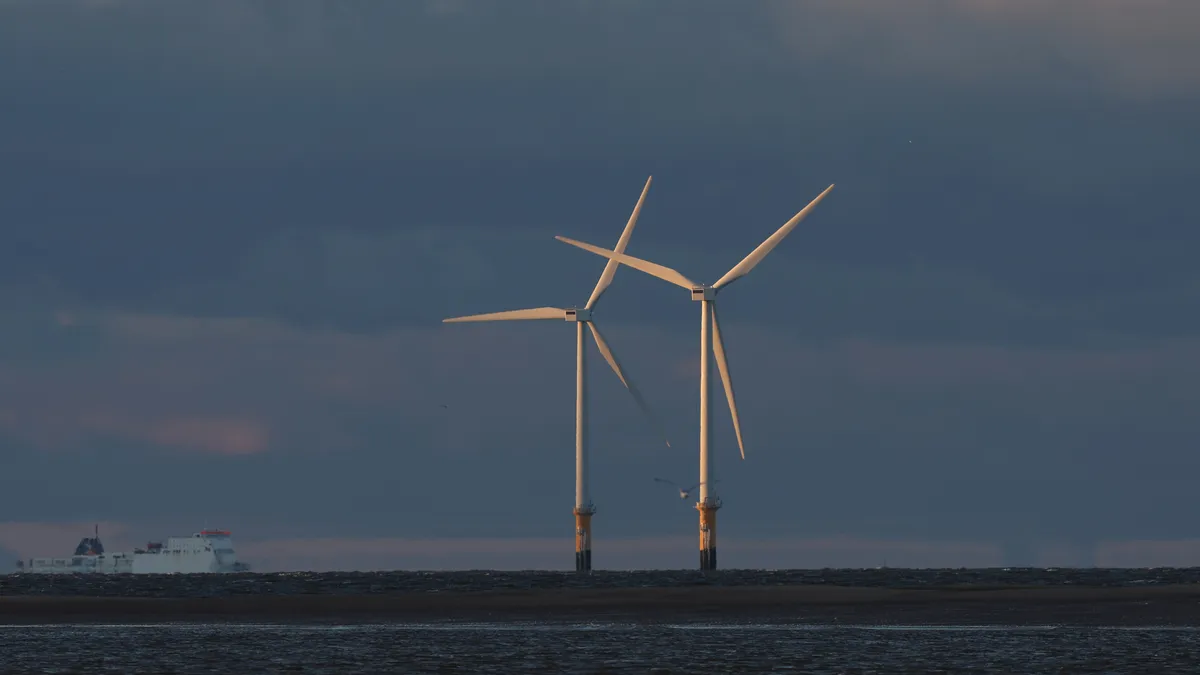Dive Brief:
- The Maine legislature on Tuesday passed a bill requiring the state to procure 3 GW of offshore wind capacity by 2040, and establishing provisions regarding the construction and siting of future projects.
- LD 1895 supports the creation of a port facility designed for fabricating and launching the materials needed to establish floating offshore wind farms, as the waters in the Gulf of Maine are too deep to accommodate fixed-bottom wind turbines.
- The bill received broad-based support from state labor and environmental groups, as well as some fishing industry groups, who supported the bill’s provision to give priority to projects sited outside of a key fishing area known as Lobster Management Area 1, or LMA-1.
Dive Insight:
While the bill didn’t receive unanimous support from the fishing industry, Natural Resources Council of Maine’s Climate and Clean Energy Director Jack Shapiro said in an interview, certain stakeholders were willing to come to the table due to an established federal plan to begin Gulf of Maine offshore wind lease sales in 2024.
“The leasing process is happening,” Shapiro said. “I think some people realized, ‘If we want to influence how offshore wind is developed, and where it's developed, this is our opportunity.’”
In addition to the bill including provisions to shield LMA-1 from future offshore wind development, Maine’s congressional delegation along with Gov. Janet Mills, D, sent a letter in June to the Bureau of Ocean Energy Management asking the agency to remove LMA-1 from consideration entirely when choosing sites for the 2024 lease sales.
The legislation, having passed both chambers of the state’s legislature, is now expected to be signed into law by Mills.
These efforts are an important part of “setting the stage” for future offshore wind development in the state, Shapiro said, and building a sustainable offshore wind industry in Maine.
“We want to build on our maritime heritage – shipbuilding, and all the things that we do as a state and have done for decades and for centuries, and to have some of the benefits of those jobs flow to Maine, as well as the urgency of acting on climate,” he said.
Shapiro said that in the Northeast, where the shallow waters of the Atlantic have allowed for the development of fixed-bottom offshore wind farms, there is no facility equipped to construct full sized floating offshore wind turbines – giving Maine the opportunity to create the first.
A supply chain for floating wind differs significantly from a fixed-bottom supply chain, Shapiro said. The “vessel needs” are different, as the turbines are assembled dockside and towed out to sea instead of being assembled in the water.
“If we are successful in developing that port, and we're constructing projects in Maine — not just to serve the three gigawatts by 2040 that we laid out in this legislation, but also building construction projects that may be selling their power to Massachusetts — the workers who are constructing these could be building a turbine or two every month for the next 30, 40, 50 years,” he said.
The legislation stipulates that future offshore wind projects use certain amounts of labor from union workers and registered apprentices. Natural Resources Council of Maine’s CEO Rebeccah Sanders said in a release that the legislation helps create a clean energy industry in the state that could bring in “thousands” of new jobs.
The Business Network for Offshore Wind congratulated Maine’s lawmakers in a release, saying that the legislation would provide a “significant boost” to the domestic floating offshore wind supply chain and help the state and the U.S. “become leaders in floating offshore wind technology.”
In preparation for the Gulf of Maine lease sales, BOEM issued July 19 a draft environmental assessment that weighs the potential impacts of a wind energy research lease that the agency would use for site assessment.
BOEM is taking comments on the assessment through Aug. 21, and will hold public meetings to discuss the review process on Aug. 1 and 3.














